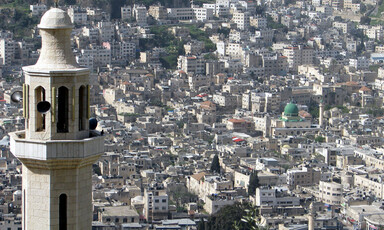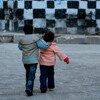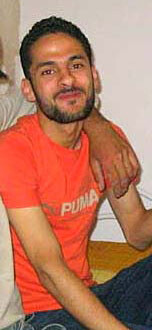
Nablus, beautiful and unvisited
Nablus 26 April 2011
Few visitors make it to the city of Nablus in the occupied West Bank, causing the city’s tourism sector to suffer. Read more about Nablus, beautiful and unvisited

Nablus 26 April 2011
Few visitors make it to the city of Nablus in the occupied West Bank, causing the city’s tourism sector to suffer. Read more about Nablus, beautiful and unvisited

Nablus, West Bank 11 January 2010
The brutal killing of three Palestinian men by Israeli military forces in Nablus last week on 26 December 2009 sparked grief and outrage across Palestine and brought the northern West Bank city to a standstill as thousands mourned the lethal attack. However, their voices are drowned out yet again by a well-played hand of Israel’s propaganda machine and repeated by the mainstream media. Bridget Chappell writes from Nablus. Read more about Nablus executions: Shoot first, ask questions later

Nablus, West Bank 22 July 2009
It was a portentous day in the occupied West Bank city of Nablus. Over 100,000 Palestinians from Haifa, Jerusalem, Jenin and more gathered in the city on Saturday to celebrate the making of a Guinness World Record: the largest plate of kanafeh, a popular red-haired pastry made with lots of sugar and goat cheese. Was it a celebration of improving economic conditions or, as one resident put it, a “shameful display of opportunism?” Sousan Hammad reports from Nablus about the absurdity of the event. Read more about Celebrating absurdity in Nablus

Nablus, West Bank 17 November 2008
Stepping out of the taxi cab and onto the gravel road, I walked towards the notorious Huwwara checkpoint near Nablus in the northern West Bank. To my left, I passed throngs of people waiting in lines barely inching along in the blistering summer heat, awaiting the apathetic wave of an Israeli soldier’s hand to be let through. Dina Elmuti writes from Nablus, occupied West Bank. Read more about The real meaning of hope

Nablus, West Bank 17 September 2008
Many Palestinians that I met during my travels in the West Bank told me that to know what Palestine really was about and meant, I had to go to Nablus. Most of them also told me that Nablus was their favorite city. After spending five weeks there this summer, I understand why. Frank Barat writes of the city that teems with life. Read more about Nablus, vibrant despite it all

Nablus, West Bank 1 April 2008
Fedaa recounted that three days ago her husband woke her at 1:15 am and told her, “ ‘There’s Jewish in our area and I am afraid about Lara alone in her room. Go to her room.’ I said, ‘Nomair, I want to sleep.’ He come back angry and said, ‘Fedaa, wake up.’ Suddenly they shoot at us. I get out and go quickly to Lara’s room. They shoot us again in Lara’s room. Nomair started shouting at them, ‘Go! What do you want? Why do you shoot us? There is a baby here.’” Alice Rothchild writes from Nablus. Read more about Returning to Nablus: Collateral damage

Nablus, West Bank 27 March 2008
It is the constant reminder that every aspect of people’s lives here is affected by the occupation. My Palestinian friends who have lived their whole lives in this context tell me that one of the worst things of existing under such conditions is that after a while it becomes normal. One comes to expect everything. One has to endure everything. One has to remain hopeful that life will become easier one day. Maria York’s words and photographs tell about daily life in the occupied West Bank. Read more about Normality in the West Bank

Nablus, West Bank 11 November 2007
Abed Shinawi has died. In the words of the Palestinians, among others, he was martyred. Martyr in Palestine refers to anyone who has died as a result of the Israeli occupation, as with the 38-year-old handicapped, wheelchair-bound man killed in an IOF invasion Nablus’ al-Ain refugee camp a month and a half ago. Or it refers into the elderly man shot five times in the chest after he opened his door to IOF assurances of his safety during the same 16 October Israeli invasion that eventually claimed Abed’s life. A friend of Abed’s writes about the young man and resistance fighter who was recently killed in Nablus. Read more about Abed the martyr

Nablus 27 August 2007
My husband and I left Amman at dawn with our three-month-old-son, and arrived at the Jordanian border control just after 8am. From there its a few minutes’ drive to the Israeli section of the border, then three-and-a-half hours of sitting in a sweltering hot bus waiting at the entrance to the border compound. It was 40 degrees celsius outside, and the stationary bus was like a greenhouse. Inside the compound, Israeli officers took me to one side as I was going through the x-ray. What followed was seven hours of waiting and wondering. Read more about Is this Jericho or Hell?

Nablus, Palestine 21 March 2007
My last day in Nablus I got to discover another one of the city’s gems: An-Najah University. I immediately took to the old architecture mixed with modern sculptures on the main campus, but what inspired me most was watching thousands of students return to the frantic bustle of daily university life so soon after soldiers had released the city from hostage. Resilience is a defining character of Palestinian identity in my experience, and I was more impressed than surprised to see Palestinians asserting their determination to get an education even in the most difficult circumstances. Read more about Existence is Resistance